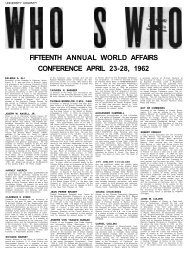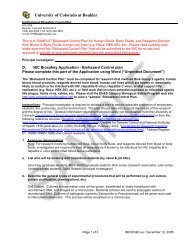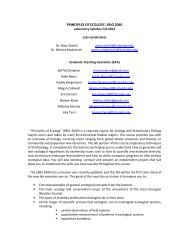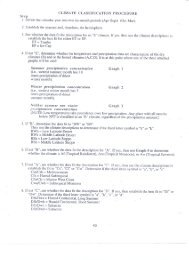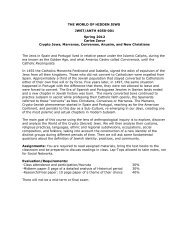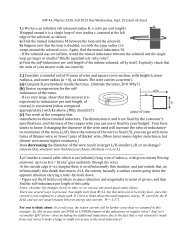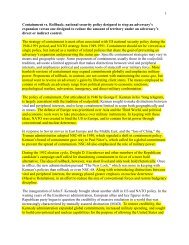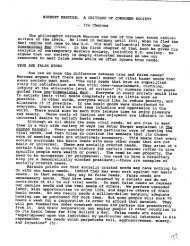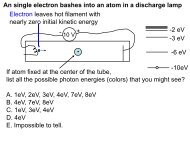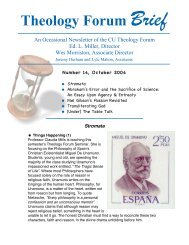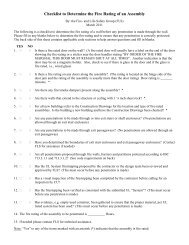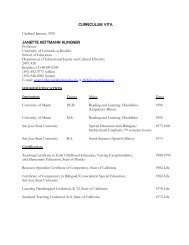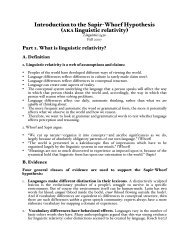Unreinforced Masonry (URM) Buildings - University of Colorado ...
Unreinforced Masonry (URM) Buildings - University of Colorado ...
Unreinforced Masonry (URM) Buildings - University of Colorado ...
You also want an ePaper? Increase the reach of your titles
YUMPU automatically turns print PDFs into web optimized ePapers that Google loves.
<strong>Unreinforced</strong> <strong>Masonry</strong> (<strong>URM</strong>) <strong>Buildings</strong><br />
The ShakeOut Scenario:<br />
U.S. Geological Survey Open File Report 2008-1150<br />
California Geological Survey Preliminary Report 25 version 1.0<br />
U.S. Geological Survey Circular 1324<br />
California Geological Survey Special Report 207 version 1.0<br />
Prepared for<br />
United States Geological Survey<br />
Pasadena CA<br />
and<br />
California Geological Survey<br />
Sacramento CA<br />
Under contract to<br />
SPA Risk LLC<br />
Denver CO<br />
By<br />
Richard L. Hess, S.E.<br />
Hess Engineering Inc.<br />
Los Alamitos CA<br />
May 2008<br />
Note: over the course <strong>of</strong> the ShakeOut Scenario, the project name<br />
evolved. Where a study mentions the SoSAFE Scenario or San Andreas<br />
Fault Scenario, it refers to what is now named the ShakeOut Scenario.
Impacts <strong>of</strong> a M7.8 Southern San Andreas Earthquake<br />
on <strong>Unreinforced</strong> <strong>Masonry</strong> (<strong>URM</strong>) <strong>Buildings</strong><br />
I Past Performance <strong>of</strong> <strong>URM</strong> <strong>Buildings</strong>: (1)<br />
Richard L. Hess, S.E.<br />
<strong>Unreinforced</strong> masonry (<strong>URM</strong>) bearing wall buildings have shown poor performance in<br />
past earthquakes: 1868 Hayward, 1906 San Francisco, 1925 Santa Barbara, 1933 Long Beach,<br />
1952 Kern County, 1971 San Fernando, 1983 Coalinga, 1987 Whittier, 1989 Loma Prieta, and<br />
1994 Northridge. The reasons for this poor performance are the inherent brittleness, lack <strong>of</strong><br />
Figure 1<br />
Most photographed commercial <strong>URM</strong> building in town, the Continental Baking<br />
Company, Long Beach, California 1933 – complete collapse<br />
(Historical Society <strong>of</strong> Long Beach, PO Box 1869, Long Beach, CA 90801 (562) 424-2220)<br />
tensile strength, and lack <strong>of</strong> ductility; that is, a lack <strong>of</strong> the properties given to reinforced masonry<br />
by the steel reinforcing. Earthquake forces oscillate, and after a crack occurs in a brittle material,<br />
subsequent pulses cause uncontrolled displacement and collapse.<br />
(1) From the Commentary on Appendix Chapter 1 <strong>of</strong> the Uniform Code for Building Conservation prepared by the<br />
Structural Engineers Association <strong>of</strong> California, December 1999.<br />
1<br />
December 28, 2007<br />
HEI #27114
<strong>Masonry</strong> is one <strong>of</strong> the oldest building materials and has been considered the most<br />
durable. However, it depends on a static, unyielding base. California happens to be a region <strong>of</strong><br />
high seismicity because it straddles the boundary between the Pacific and North American<br />
Plates. However, not many large earthquakes occurred during the first part <strong>of</strong> the twentieth<br />
century when southern California was experiencing a high growth rate, and it was during that<br />
period that many <strong>URM</strong> buildings were constructed.<br />
After the 1933 Long Beach earthquake, building codes changed prohibiting unreinforced<br />
masonry buildings, and few have been built in California since then; however, there are <strong>URM</strong><br />
buildings that remain, which fall into three categories: 1) fully retr<strong>of</strong>itted; 2) partially retr<strong>of</strong>itted;<br />
and 3) not retr<strong>of</strong>itted. Following the lead <strong>of</strong> the cities <strong>of</strong> Long Beach in the 1970’s and Los<br />
Angeles in the 1980’s, the State <strong>of</strong> California declared, through Senate Bill 547 (Section 8875 et<br />
seq. <strong>of</strong> the Government Code), that the hazard posed by this class <strong>of</strong> building is unacceptable and<br />
that communities must identify them. The Senate bill does not specify the level <strong>of</strong> performance<br />
required or expected, but leaves it up to each community.<br />
Figure 2<br />
Morrison Apartments, 915 E. Ocean, Long Beach, California 1933 – Front wall<br />
only fell away from floors and ro<strong>of</strong> onto street below due to directional<br />
properties <strong>of</strong> earthquake<br />
(Historical Society <strong>of</strong> Long Beach, PO Box 1869, Long Beach, CA 90801 (562) 424-2220)<br />
It is generally accepted that the intensity <strong>of</strong> earthquakes which could be reasonably<br />
expected to occur in California would be sufficient to cause buildings with minimal seismic<br />
resistance characteristics to be seriously damaged or, perhaps, to collapse, causing serious injury<br />
2<br />
December 28, 2007<br />
HEI #27114
or death to the occupants or passers-by. Figures 1 and 2 show the collapse <strong>of</strong> <strong>URM</strong> buildings<br />
from the 1933 earthquake.<br />
II Overview and Historical Background <strong>of</strong> Seismic Strengthening Codes and Regulations<br />
for <strong>URM</strong> Bearing Wall <strong>Buildings</strong> in California: (1)<br />
The goal <strong>of</strong> <strong>URM</strong> retr<strong>of</strong>it codes and ordinances has been to reduce life-safety hazards as<br />
best possible with the available resources. The efforts are directed to insuring a coherent load<br />
path for lateral loads, reduction <strong>of</strong> out-<strong>of</strong>-plane wall failures, reduction <strong>of</strong> loss <strong>of</strong> support for<br />
floors and ro<strong>of</strong>s, and reduction <strong>of</strong> falling parapets or ornamentation. Application <strong>of</strong> these<br />
Provisions will decrease the probability <strong>of</strong> loss <strong>of</strong> life, but loss <strong>of</strong> life cannot be prevented.<br />
Many retr<strong>of</strong>itted <strong>URM</strong> buildings will sustain substantial damage, which may make future repair<br />
rather than replacement uneconomical.<br />
Figure 3<br />
Partial collapse <strong>of</strong> a retr<strong>of</strong>itted <strong>URM</strong> with walls that exceed h/t limitations.<br />
(Earthquake Spectra, January 1996 Supplement C to Volume 11)<br />
Since the early 1950’s, the city <strong>of</strong> Long Beach, California, has adopted a series <strong>of</strong><br />
ordinances that addressed the earthquake hazard <strong>of</strong> <strong>URM</strong> buildings. The current ordinance,<br />
adopted in 1976, has been used as a model by some other communities.<br />
3<br />
December 28, 2007<br />
HEI #27114
The City <strong>of</strong> Los Angeles adopted an earthquake safety ordinance in January, 1981. The<br />
ordinance, originally designated Division 68, has become a model for other communities and for<br />
the State model ordinance; it is commonly referred to as “Division 88” from its chapter number<br />
in the code. The ordinance requires evaluation and upgrading <strong>of</strong> buildings that have bearing<br />
walls <strong>of</strong> unreinforced masonry. In these provisions, the prescribed force levels are only<br />
applicable for seismic zone 4 and are reduced for buildings with an occupant load <strong>of</strong> less than<br />
100 (and if they have crosswalls in all stories), and increased for essential buildings. The<br />
comparable section <strong>of</strong> the Los Angeles County Building Code is Chapter 96.<br />
In December, 1987, the Seismic Safety Commission, in response to Senate Bill 547 (“the<br />
<strong>URM</strong> Law”), published a two-volume report (SSC, 1987) consisting <strong>of</strong> (1) Guidebook, which<br />
<strong>of</strong>fers assistance to local government in meeting the requirements <strong>of</strong> the <strong>URM</strong> Law, and (2)<br />
Appendix, which repeats several pertinent codes and a model ordinance called Rehabilitation <strong>of</strong><br />
Hazardous <strong>Masonry</strong> <strong>Buildings</strong>: A Draft Model Ordinance (SSC, 1985). The SSC model<br />
ordinance is based on Division 88 and has been recommended to local governments in zone 4 as<br />
a mitigation program that complies with the <strong>URM</strong> Law. A version <strong>of</strong> Division 88 appears in<br />
Appendix Chapter 1 <strong>of</strong> the 1985 and 1988 Editions <strong>of</strong> the Uniform Code for Building<br />
Conservation (UCBC).<br />
Figure 4<br />
Out-<strong>of</strong>-plane damage to a retr<strong>of</strong>itted <strong>URM</strong> building with a clipped corner<br />
(Earthquake Spectra, January 1996 Supplement C to Volume 11)<br />
III Relevance <strong>of</strong> Past Experience for Future Performance: (1)<br />
4<br />
December 28, 2007<br />
HEI #27114
Experience with <strong>URM</strong> buildings in the 1987 Whittier, 1989 Loma Prieto, and 1994<br />
Northridge earthquakes is relevant to future expectations ins<strong>of</strong>ar as the magnitude <strong>of</strong> shaking is<br />
concerned. However, we do not have experience with the higher magnitude and longer duration<br />
that will occur near (within 30-50 km <strong>of</strong>) the San Andreas Fault. The Northridge and Loma<br />
Prieta durations were seven seconds, while the 1906 San Francisco duration was 110 seconds.<br />
After the Northridge event, some buildings that had not collapsed showed displaced supports that<br />
appeared ready to collapse after one or two more ground oscillations.<br />
The minimum required procedure <strong>of</strong> earthquake hazard reduction has been described by<br />
the following descriptive items.<br />
• Remove parapets and ornamentation above the ro<strong>of</strong>line or brace these<br />
items to the ro<strong>of</strong>.<br />
• Anchor the Exterior and interior <strong>URM</strong> walls to the ro<strong>of</strong> and floor framing.<br />
• Check the height/thickness ratios <strong>of</strong> the <strong>URM</strong> walls to verify their out-<strong>of</strong>plane<br />
stability. Brace wall if required.<br />
• Develop horizontal diaphragms at each wall-bracing level. Verify<br />
adequacy <strong>of</strong> these diaphragms to control the relative dynamic<br />
displacement <strong>of</strong> the center <strong>of</strong> the diaphragm span.<br />
• Develop adequate in-plane strength <strong>of</strong> <strong>URM</strong> walls and other elements that<br />
control interstory displacements.<br />
5<br />
December 28, 2007<br />
HEI #27114
Figure 5<br />
Typical failure <strong>of</strong> a 9-inch masonry wall with an unbonded veneer course. Note<br />
successful performance <strong>of</strong> the wall anchors.<br />
(Earthquake Spectra, January 1996 Supplement C to Volume 11)<br />
Past risk reduction procedures have applied to the overall average performance <strong>of</strong><br />
rehabilitated unreinforced masonry (<strong>URM</strong>) buildings, and especially to life safety. An individual<br />
building may have damage levels above or below the average depending on its structural<br />
characteristics and the local ground motion. If it has features other than being rectangular with<br />
continuous floor and ro<strong>of</strong> diaphragms, additional damage will occur unless the retr<strong>of</strong>it engineer<br />
and contractor correctly deal with these irregularities. Please refer to Figures 3-6 for damage to<br />
retr<strong>of</strong>itted <strong>URM</strong> buildings during the Northridge earthquake.<br />
Past experience is relevant in proving that retr<strong>of</strong>itting <strong>URM</strong> buildings reduces damage<br />
and loss <strong>of</strong> life, but also that building configuration and the quality <strong>of</strong> the evaluation, design and<br />
construction makes a substantial difference in the degree <strong>of</strong> improvement.<br />
6<br />
December 28, 2007<br />
HEI #27114
Figure 6<br />
Collapse <strong>of</strong> a retr<strong>of</strong>itted <strong>URM</strong> tower onto the second floor and the street below.<br />
(Earthquake Spectra, January 1996 Supplement C to Volume 11)<br />
IV Regional Damage Scenarios:<br />
Figure 7 shows the number <strong>of</strong> <strong>URM</strong> buildings in Los Angeles City after the Northridge<br />
earthquake <strong>of</strong> 1994, in a report for the City <strong>of</strong> Los Angeles Task Force on Building Damage.<br />
This tabulation shows that 2.5% <strong>of</strong> retr<strong>of</strong>itted buildings were damaged over 10%, and 0.3% were<br />
damaged over 50%. For non-retr<strong>of</strong>itted buildings, 10.5% were damaged over 10%, and 7% had<br />
damage over 50%. This demonstrates the value <strong>of</strong> the retr<strong>of</strong>it program.<br />
7<br />
December 28, 2007<br />
HEI #27114
Figure 7<br />
<strong>URM</strong> Data for City <strong>of</strong> Los Angeles Arranged by City Council District and MMI<br />
(Earthquake Spectra, January 1996 Supplement C to Volume 11)<br />
As a measure <strong>of</strong> the effectiveness <strong>of</strong> the <strong>URM</strong> Law and these retr<strong>of</strong>it ordinances, Report<br />
SSC 2006-04 prepared by the California Seismic Safety Commission for the Legislature details<br />
the current status <strong>of</strong> California’s <strong>URM</strong> Building Law. It states that approximately 25,900 <strong>URM</strong><br />
buildings with an average size <strong>of</strong> 10,000 square feet have been inventoried in Zone 4’s 365<br />
jurisdictions. The average mitigation rate is 70% statewide, and Los Angeles and Orange<br />
Counties have 87% and 89% rates respectively. Appendix A <strong>of</strong> that report, Figure 8, shows the<br />
percent <strong>of</strong> buildings that have been mitigated in each <strong>of</strong> the affected counties.<br />
Figure 8<br />
8<br />
December 28, 2007<br />
HEI #27114
SSC 2006 Survey <strong>of</strong> City and County Mitigation Efforts in Seismic Zone 4<br />
(SSC 2006-04)<br />
We would expect a higher rate <strong>of</strong> damage near the southern San Andreas Fault; however,<br />
there is no reason to think that the difference between retr<strong>of</strong>itted and non-retr<strong>of</strong>itted would not be<br />
the same as in Los Angeles. This fault does not pass through any large densely populated areas;<br />
however, its magnitude and duration will be larger and will affect areas at greater distance than<br />
faults in the Los Angeles Basin.<br />
The magnitude and duration <strong>of</strong> shaking on the San Andreas will be greater than the<br />
Northridge earthquake. Therefore, although quantitative data is not available, I expect that<br />
essentially all (90%) <strong>URM</strong> buildings within 30 km to 60 km will be destroyed beyond<br />
economical repair, and lives will be lost, especially in multistory, non-retr<strong>of</strong>itted buildings.<br />
The critical part <strong>of</strong> the southern San Andreas Fault originates in Imperial County near<br />
Salton City and proceeds in a northwest direction near Palm Springs, Yucaipa, San Bernardino,<br />
Palmdale and Taft on the boundary between Kern and San Luis Obispo Counties.<br />
The following table summarizes the number <strong>of</strong> retr<strong>of</strong>itted and non-retr<strong>of</strong>itted <strong>URM</strong><br />
buildings in cities near the southern San Andreas Fault:<br />
City<br />
Miles north from<br />
origin <strong>of</strong> event<br />
Distance from<br />
fault No. <strong>of</strong> <strong>URM</strong> % Mitigation No. Mitigated<br />
Indio 40 m 5 km 48 0% 0<br />
Palm Desert 46 m 13 km 3 100% 3<br />
Palm Springs 60 m 10 km 26 96% 25<br />
Banning 80 m 8 km 49 92% 45<br />
Beaumont 85 m 12 km 37 46% 17<br />
Yucaipa 90 m 5 km 14 0% 0<br />
Redlands 100 m 9 km 77 0% 0<br />
Highland 104 m 4 km 12 25% 3<br />
Riverside 108 m 33 km 200 22% 44<br />
San Bernardino 110 m 8 km 170 41% 70<br />
Colton 112 m 17 km 20 0% 0<br />
Rialto 114 m 13 km 19 21% 4<br />
Fontana 120 m 20 km 85 20% 17<br />
Palmdale 165 m 2 km 0 N.A.<br />
Maricopa 238 m 12 km 14 7% 1<br />
Taft 245 m 11 km 40 0% 0<br />
(totals:) 814 28% 229<br />
V Cost and Down Time:<br />
9<br />
December 28, 2007<br />
HEI #27114
The 2006 Progress Report (SSC 2006-04) on <strong>URM</strong> building retr<strong>of</strong>it by the Seismic<br />
Safety Commission has inventoried approximately 25,900 <strong>URM</strong> buildings with an average size<br />
<strong>of</strong> 10,000 square feet in seismic zone 4 <strong>of</strong> California. This includes apartments, <strong>of</strong>fices, stores<br />
and industrial with a probable average building value <strong>of</strong> $100.00 to $80.00 per square foot,<br />
respectively. Because <strong>of</strong> the era in which they were built, a high percentage <strong>of</strong> the commercial<br />
and industrial buildings contain residential areas on upper floors. Using a rough estimate <strong>of</strong> 250<br />
square feet per occupant, this equates to an average <strong>of</strong> 40 people per building.<br />
Our tabulation along the San Andreas Fault totaled 814 units and the City <strong>of</strong> Los Angeles<br />
inventoried 8,242. Therefore, a reasonable estimate <strong>of</strong> buildings significantly affected by this<br />
seismic event would be in the range <strong>of</strong> 10,000 to 12,000. In 2006, it was estimated that 70% <strong>of</strong><br />
these <strong>URM</strong> buildings were retr<strong>of</strong>itted.<br />
Using the Los Angeles City 1994 <strong>URM</strong> data, 10.5% <strong>of</strong> unstrengthened buildings and<br />
2.5% <strong>of</strong> strengthened buildings had over 10% damage. This would, in most cases, require<br />
relocation <strong>of</strong> the users <strong>of</strong> those buildings.<br />
If it is assumed that 11,000 buildings will be affected, 90% <strong>of</strong> 1000 relatively near the<br />
fault will have total damage, and 2.5% <strong>of</strong> 7000 strengthened buildings and 10.5% <strong>of</strong> 3000<br />
unstrengthened buildings will have over 10% damage.<br />
The total number <strong>of</strong> buildings that will have personnel relocated will be:<br />
90% <strong>of</strong> 1000 = 900<br />
2.5% <strong>of</strong> 7000 = 175<br />
10.5% <strong>of</strong> 3000 = 315<br />
1,390 buildings<br />
1,390 x 40 = 55,600 people<br />
Unlike buildings made <strong>of</strong> other material, it is probable that virtually all <strong>URM</strong> buildings<br />
with over 10% damage will be replaced rather than repaired after an earthquake. Therefore, the<br />
loss in value would be in the neighborhood <strong>of</strong>:<br />
1,390 units x 10,000 sf/unit x $90/sf = $1.25 billion<br />
If the 3,000 unstrengthened <strong>URM</strong> buildings were retr<strong>of</strong>itted, according to these statistics,<br />
240 fewer buildings would be damaged at a savings <strong>of</strong> approximately $216 million, and almost<br />
10,000 fewer people would be displaced, i.e., 46,000 instead <strong>of</strong> 55,600. In addition, the<br />
incidence <strong>of</strong> injuries and deaths would also decrease proportionately. This easily justifies the<br />
cost <strong>of</strong> retr<strong>of</strong>itting these remaining buildings.<br />
10<br />
December 28, 2007<br />
HEI #27114
VI Recommendation for Mitigation <strong>of</strong> Injury and Loss <strong>of</strong> Life Danger:<br />
Past efforts to require retr<strong>of</strong>it <strong>of</strong> <strong>URM</strong> buildings have been successful, and lives have<br />
been saved. For example, there was no loss <strong>of</strong> life due to <strong>URM</strong> building collapse in the 1994<br />
Northridge earthquake, although some buildings were damaged beyond economical repair.<br />
Another justification <strong>of</strong> the rationale to limit required retr<strong>of</strong>it to the life safety level is that, in<br />
many cases, the building is commercially obsolete due to parking or mechanical-electricalplumbing<br />
requirements or under utilization <strong>of</strong> the property on which it stands, and many<br />
damaged buildings were removed after the earthquake and new buildings built in their place.<br />
Partially and non-retr<strong>of</strong>itted buildings, in general, pose a greater risk to people both<br />
inside and out, and jurisdictions which have not undertaken an active mandatory retr<strong>of</strong>it program<br />
should assess the condition <strong>of</strong> their inventory <strong>of</strong> <strong>URM</strong> buildings, first by initial screening and<br />
then making a structural evaluation <strong>of</strong> those that could pose a significant risk.<br />
All <strong>URM</strong> buildings have been identified by each jurisdiction in accordance with SB 547.<br />
Initial screening will eliminate buildings that do not have <strong>URM</strong> walls supporting floors, ro<strong>of</strong>s or<br />
upper story walls weighing at least 100 pounds per linear foot. On buildings that have been<br />
retr<strong>of</strong>itted, there should be record <strong>of</strong> the design by an appropriately registered Civil or Structural<br />
engineer.<br />
Retr<strong>of</strong>itted <strong>URM</strong> buildings may have structural deficiencies that are not unique to that<br />
material, but which pose a known threat <strong>of</strong> collapse. The most common <strong>of</strong> these is the weak or<br />
s<strong>of</strong>t story. This condition is identified by a lack <strong>of</strong> shear wall on one side in a multi-story<br />
building; a common condition in commercial buildings with storefront glass at street level.<br />
These buildings, depending on the geometry <strong>of</strong> their floor plan, may rotate to such an extent that<br />
the side walls lean over and are no longer able to support the floor above.<br />
Another deficiency sometimes found in a retr<strong>of</strong>itted <strong>URM</strong> building is that the exterior<br />
wythe may not be connected by headers and therefore should be considered veneer and not be<br />
counted in the width <strong>of</strong> the wall. Most codes require that not less than 4% <strong>of</strong> the area <strong>of</strong> each<br />
wall face be composed <strong>of</strong> headers. In an earthquake, the veneer may fall away, leaving a heightto-thickness<br />
ratio <strong>of</strong> the remaining structural wall inadequate to support the imposed loads. This<br />
falling veneer can be a major threat to life on the surrounding streets.<br />
ASCE Standard 31-03, Seismic Evaluation <strong>of</strong> Existing <strong>Buildings</strong>, contains checklists in<br />
Section 3.7.15 and 3.7.15A for Tier 1 screening <strong>of</strong> <strong>URM</strong> buildings with flexible and stiff<br />
diaphragms, respectively. This document should be used to determine the need for further<br />
analysis and retr<strong>of</strong>it. ATC 20 and ATC 20-2, Procedure for Postearthquake Safety Evaluation <strong>of</strong><br />
<strong>Buildings</strong> and the Addendum, respectively, are also sources <strong>of</strong> information for the evaluation <strong>of</strong><br />
possible failure scenarios.<br />
Because <strong>of</strong> limited effectiveness <strong>of</strong> voluntary retr<strong>of</strong>it programs, the California Seismic<br />
Safety Commission has made the following recommendation to the Legislature in its 2006<br />
Progress Report:<br />
11<br />
December 28, 2007<br />
HEI #27114
• Mandate the strengthening <strong>of</strong> all unreinforced masonry bearing buildings<br />
including state-owned buildings in accordance with the State’s model<br />
building code.<br />
• Recommend that local governments with little or no retr<strong>of</strong>it progress<br />
provide incentives to encourage owners to retr<strong>of</strong>it.<br />
• Adopt the International Existing Building Code as the State’s model<br />
building code so that future alterations to existing buildings trigger seismic<br />
retr<strong>of</strong>its to the latest standards.<br />
• Establish retr<strong>of</strong>it standards and mitigation programs for other types <strong>of</strong><br />
collapse-risk buildings such as s<strong>of</strong>t-story apartments, tilt-ups and older<br />
concrete buildings.<br />
• Chapter 308 <strong>of</strong> the Statutes <strong>of</strong> 2004 prohibits local governments from<br />
imposing additional building or site conditions such as parking spaces, or<br />
other onsite or <strong>of</strong>fsite requirements or fees on or before the issuance <strong>of</strong> a<br />
building permit for seismic retr<strong>of</strong>its. The Commission does not<br />
recommend the extension <strong>of</strong> its sunset date <strong>of</strong> January 1, 2009.<br />
Following these recommendations will save lives and reduce the cost <strong>of</strong> dealing with the<br />
aftermath <strong>of</strong> a M7.8 southern San Andreas earthquake.<br />
12<br />
December 28, 2007<br />
HEI #27114
References:<br />
ABK, 1984<br />
Methodology for Mitigation <strong>of</strong> Seismic Hazards in Existing <strong>Unreinforced</strong> <strong>Masonry</strong><br />
<strong>Buildings</strong>: The Methodology, Topical Report 08, National Science Foundation,<br />
Contract No. NSF-C-PFR78-19200, Applied Science and Research Applications,<br />
Washington, D.C. 20550<br />
ABK, 1986<br />
Guidelines for the Evaluation <strong>of</strong> Historic Brick <strong>Masonry</strong> <strong>Buildings</strong> in Earthquake<br />
Hazard Zones, ABK, A Joint Venture, Funded by the Department <strong>of</strong> Parks and<br />
Recreation <strong>of</strong> the State <strong>of</strong> California and the National Park Service, United States<br />
Government, January 1986<br />
Army, 1986<br />
Seismic Design Guidelines for Essential <strong>Buildings</strong>, Departments <strong>of</strong> the Army (TM-809-<br />
10-1), Navy (NAVFAC P355.1), and the Air Force (AFM 88-3, Chap. 13, Sect. A),<br />
Washington, D.C.<br />
Army, 1988<br />
Seismic Design Guidelines for Upgrading Existing <strong>Buildings</strong>, Departments <strong>of</strong> the Army<br />
(TM-809-10-2), Navy (NAVFAC P355.2), and the Air Force (AFM 88-3, Chap. 13,<br />
Sect. B), Washington, D.C.<br />
Asakura, A., 1987<br />
Program for Strengthening <strong>of</strong> <strong>Unreinforced</strong> Brick <strong>Masonry</strong> <strong>Buildings</strong> in Los Angeles,<br />
Allen A. Asakura, Proceedings <strong>of</strong> the Second Joint USA-Italy Workshop on Evaluation<br />
and Retr<strong>of</strong>it <strong>of</strong> <strong>Masonry</strong> Structures, August 1987, edited by James Noland, Atkinson-<br />
Noland & Associates, Boulder, <strong>Colorado</strong>.<br />
ASCE, 2003<br />
Seismic Evaluation <strong>of</strong> Existing <strong>Buildings</strong>, American Society <strong>of</strong> Civil Engineers<br />
ASCE/SEI 31-03<br />
ATC, 1978<br />
Tentative Provisions for the Development <strong>of</strong> Seismic Regulations for <strong>Buildings</strong>,<br />
Applied Technology Council Report ATC 3-06.<br />
13<br />
December 28, 2007<br />
HEI #27114
ATC, 1987<br />
Evaluating the Seismic Resistance <strong>of</strong> Existing <strong>Buildings</strong>, Applied Technology Council<br />
Report ATC-14, Redwood City, California<br />
ATC, 1989<br />
Procedures for Postearthquake Safety Evaluation <strong>of</strong> <strong>Buildings</strong>, Applied Technology<br />
Council ATC 20<br />
ATC, 1995<br />
Addendum to the ATC-20 postearthquake building safety evaluation procedures,<br />
Applied Technology Council ATC 20-2<br />
BSSC, 1988<br />
NEHRP Recommended Provisions for the Development <strong>of</strong> Seismic Regulations for<br />
New <strong>Buildings</strong>, Building Seismic Safety Council, Washington, D.C., (Parts I, II, and<br />
Maps).<br />
GSA, 1976<br />
Earthquake Resistance <strong>of</strong> <strong>Buildings</strong>, Vol. I-III, General Services Administration,<br />
Washington, D.C.<br />
Historical Society <strong>of</strong> Long Beach, 1981<br />
Earthquake ’33 – A Photographic History, Historical Society <strong>of</strong> Long Beach, P.O. Box<br />
1869, Long Beach, California 90801<br />
ICBO, 1976<br />
Uniform Building Code<br />
ICBO, 1985, 1988, 1991<br />
Uniform Code for Building Conservation, International Conference <strong>of</strong> Building<br />
Officials, 5360 South Workman Mill Road, Whittier, California 90601.<br />
Kariotis, 1989<br />
U.S. Practice in Evaluating, Strengthening, and Retr<strong>of</strong>itting <strong>Masonry</strong> <strong>Buildings</strong>, John<br />
Kariotis, Proceedings <strong>of</strong> an International Seminar on Evaluating, Strengthening, and<br />
14<br />
December 28, 2007<br />
HEI #27114
Retr<strong>of</strong>itting <strong>Masonry</strong> <strong>Buildings</strong>, Arlington, Texas, October, 1989, published by the<br />
<strong>Masonry</strong> Society.<br />
Rutherford & Chekene, 1990<br />
Seismic Retr<strong>of</strong>itting Alternatives for San Francisco’s <strong>Unreinforced</strong> <strong>Masonry</strong> <strong>Buildings</strong>,<br />
Rutherford and Chekene, Consulting Engineers, San Francisco, California, 1990.<br />
SEAOC, 1990<br />
Recommended Lateral Force Requirements and Tentative Commentary, Seismology<br />
Committee, Structural Engineers Association <strong>of</strong> California, San Francisco, California.<br />
SEAOSC, 1987<br />
Draft Chapter A1 (1) Earthquake Hazard Reduction in Existing <strong>Buildings</strong>, the<br />
Hazardous Building Committee <strong>of</strong> the Structural Engineers Association <strong>of</strong> Southern<br />
California, October 29, 1987.<br />
SSC, 1985<br />
Rehabilitation <strong>of</strong> Hazardous <strong>Masonry</strong> <strong>Buildings</strong>: a Draft Model Ordinance, Report No.<br />
SSC 85-06, California Seismic Commission, 1900 K Street, Suite 100, Sacramento,<br />
California 95814.<br />
SSC, 1987<br />
Guidebook and Appendix, Report No. SSC 87-03, California Seismic Safety<br />
Commission, 1900 K Street, Suite 100, Sacramento, California 95814.<br />
SSC 2006<br />
Status <strong>of</strong> the <strong>Unreinforced</strong> <strong>Masonry</strong> Building Law, 2006 Progress Report to the<br />
Legislature, Seismic Safety Commission SSC 2006-04<br />
15<br />
December 28, 2007<br />
HEI #27114



